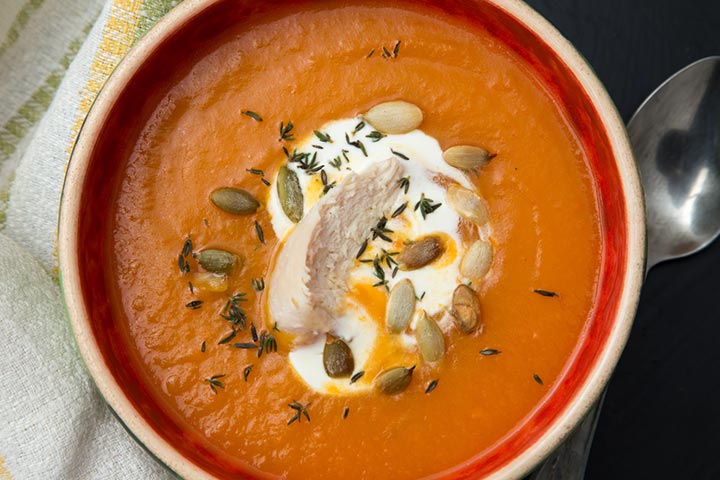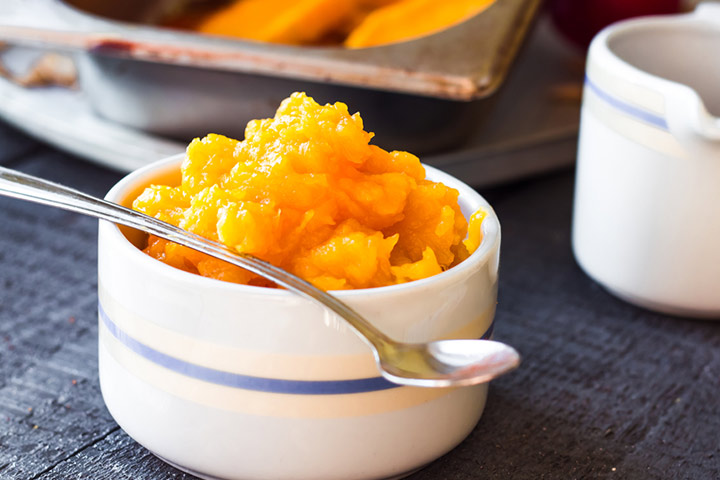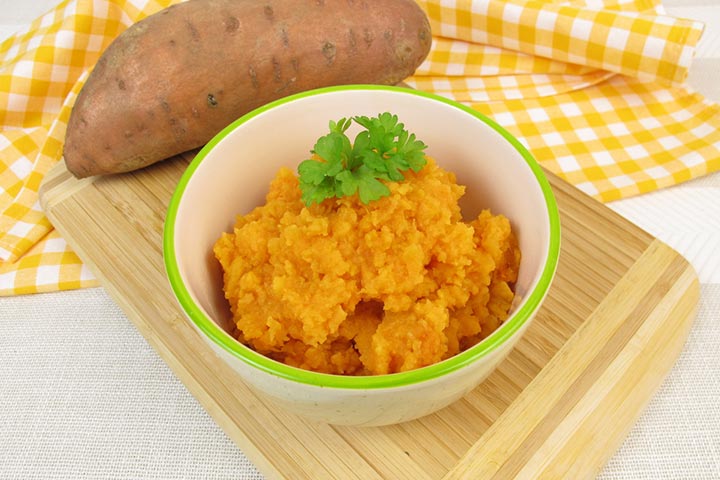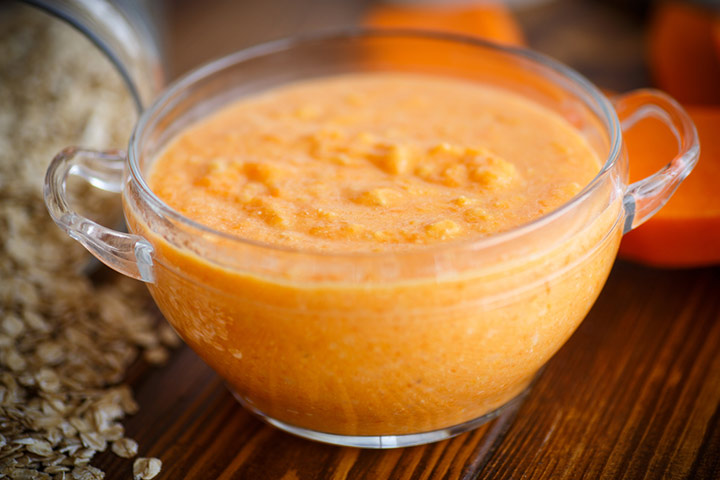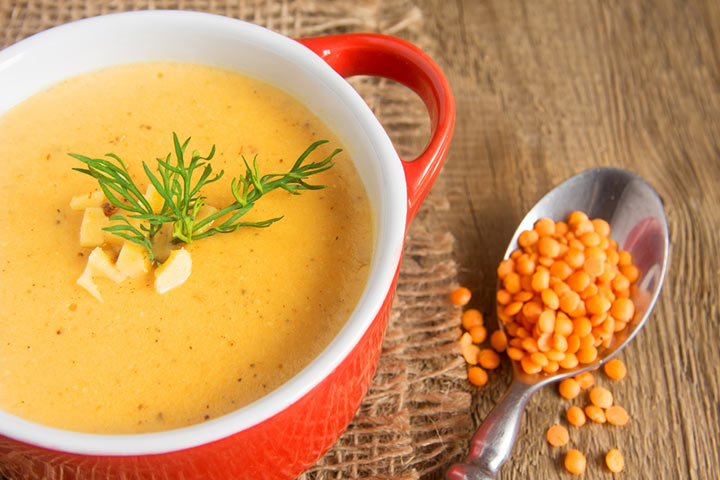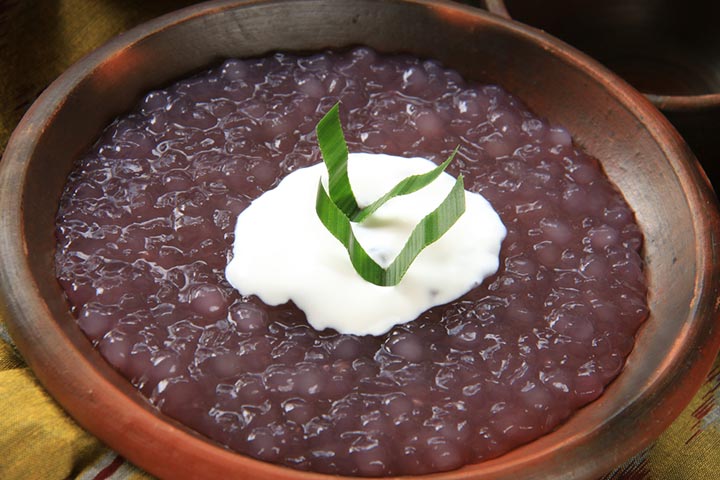Butternut squash, commonly known as squash, is a fruit in the botanical sense; however, it can be baked, roasted, pureed, and combined with other vegetables. Since it is a good source of several minerals, many mothers look for interesting butternut squash baby food recipes.
Butternut squash is high in vitamins A, B, C, and E, making it an excellent choice for your baby’s diet. It is also a good source of calcium and zinc.
This post explains the nutritional value of butternut squash and how to prepare it in an age-appropriate manner for babies if you wish to include it in their diet.
When Can Babies Have Butternut Squash?
Butternut squash can be given to babies at the age of six months (1), as a part of their solid diet. According to the CDC National Center for Health Statistics (NCHS), about 4.4% percent of children under five were affected by food allergies in 2021. Therefore, consult the doctor before introducing this vegetable if your baby has any food allergies or related symptoms.
Health Benefits Of Butternut Squash For Babies
Here’s how your baby can benefit from eating butternut squash (2) (3) (4):
- Good for the eyes: Butternut squash is rich in alpha-carotene and beta-carotene compounds, which convert into vitamin A inside the body. Vitamin A is essential for healthy eyes.
- Promotes digestion:Butternut squash is rich in fiber, which promotes healthy bowel movement. It eventually helps minimize indigestion and constipation in babies.
- Reduces inflammation: Antioxidants in squash have anti-inflammatory properties that can help if the baby has inflammatory auto-immune diseases.
- Good for the immune system: Squash contains vitamin C and nearly all B-complex vitamins, which ensure optimum functioning of the immune system.
- Rich source of micronutrients:Vital micronutrients like calcium, magnesium, and potassium are found in abundance in butternut squash. These micronutrients are important for a healthy circulatory system and nervous system. Also, winter squash can be an excellent source of calcium for babies growing in vegan households.
Just a little bit of this vegetable can add significant value to the baby’s daily diet.
Nutritional Value Per 100g Of Butternut Squash
| Nutrient | Unit value per 100g |
|---|---|
| Energy | 45kcal |
| Carbohydrates | 11.69g |
| Natural sugars | 2.2g |
| Fiber | 2g |
| Protein | 1g |
| Fat | 0.1g |
| Calcium | 48mg |
| Iron | 0.7mg |
| Magnesium | 34mg |
| Phosphorus | 33mg |
| Potassium | 352mg |
| Sodium | 4mg |
| Manganese | 0.202mg |
| Copper | 0.072mg |
| Zinc | 0.15mg |
| Selenium | 0.5µg |
| Vitamin C | 21mg |
| Vitamin B1 (Thiamin) | 0.1mg |
| Vitamin B2 (Riboflavin) | 0.02mg |
| Vitamin B3 (Niacin) | 1.2mg |
| Vitamin B5 (Pantothenic acid) | 0.4mg |
| Vitamin B6 | 0.154mg |
| Vitamin B9 (Folate) | 27µg |
| Vitamin A | 532µg |
| Vitamin E | 1.44mg |
| Vitamin K | 1.1µg |
Source: United States Department of Agriculture (5)
How To Select And Store Butternut Squash?
Select: Butternut squash has an orange-tan color and is taller than other squashes. It is characterized by a round and flat bottom.
Choose a ripened and sweet butternut squash that is deep orangish-tan. Avoid those with a dull coloration and blemishes. Opting for an organic variety would guarantee the protection of the infants from harmful fertilizers and pesticides.
Touch the squash gently to check for its firmness. Ripe butternut squash will feel tender but will not yield to the pressure of the fingers. If it does, then it is overripe. If the squash feels hard, then it is under-ripe and should be given a pass.
Storage: Cover the open pulpy section of a cut/used squash with a cling film before storing it in the refrigerator. Squash can be stored for days together, but when using it for a baby, it is best to consume it within a day.
How To Cook Butternut Squash For Baby Food?
The pulp of the butternut squash is best processed through oven-roasting, steaming, or baking. It helps retain the best taste of the vegetable while also keeping the nutrients intact. You may use the below steps to cook butternut squash for babies:
1. Oven roasting:
- Peel the squash and cut the pulp into small chunks.
- Preheat the oven to 350 °F (176 °C). Grease the butternut squash pieces with a tiny amount of vegetable oil.
- Place the squash on a baking tray and roast in the oven for 30-40 minutes.
- Let it cool before serving to the baby. Roasted butternut squash pieces work great as finger food for an older infant.
2. Baking:
- Cut the squash into two halves in length. Scoop out the lower section that has seeds.
- Preheat the oven to 350 °F (176 °C). Place the two halves of squash on a baking tray.
- Bake for an hour. Once done, scoop out the soft pulp from skin. Puree or mash the baked pulp before feeding your little one.
3. Steaming:
- Cut the squash into small cubes.
- Pour about an inch of water in a cooking pot. Place the steamer inside with the squash cubes on top of it.
- Steam the squash for about seven to ten minutes on a medium flame. Check if they are cooked by gently poking them with a fork.
- After batch cooking, let the squash cool before serving as finger food or making it into a puree.
Mashed butternut squash can be an excellent replacement for mashed potatoes. Older babies may also be served lightly fried butternut squash chunks or spiral shape pieces, which can be a replacement for spaghetti.
Butternut Squash Food Combinations For Babies
You can combine butternut squash with the following food items for best results.
- Vegetables: Root vegetables like carrots, beetroot, and sweet potato go well with squash. Sago pearl, which is made from the root of the cassava plant, tastes good with squash. A stem vegetable like a potato can also be combined with butternut squash.
- Fruits: Fruits like peaches and pears with mildly sweet and soft pulp can be mixed with squash.
- Meat: Meat from chicken and lamb taste best in combination with squash when preparing baby food.
- Pulses and grains: Squash can be combined with grains like rice and millet. Lentils, which are pulses, also make an excellent accompaniment to butternut squash.
Yummy Butternut Squash Baby Food Recipes
Here are 9 homemade butternut squash baby food recipes packed with nourishment. Most of them are vegetarian, vegan, gluten-free, and dairy-free.
1. Squash and applesauce puree
The sweet taste of the applesauce enhances the flavor of the butternut squash pulp and will be a hit if you are following baby-led weaning.
You will need:
- 1 cup cubed squash pulp
- 1 cup chopped apples with peel
- 3-4 cups of water
How to:
- Bake or steam the squash and let it cool after cooking.
- Preheat the oven to 400 °F (204 °C). Bake the apple pieces for 40 minutes.
- Once baked, cool the apples and transfer them to a blender. Add one to two cups of water and blend.
- Once the applesauce is ready, add the cooked squash, some more water, and blend them all.
2. Chicken and butternut squash puree
Chicken combined with butternut squash pulp make a thick and filling puree for a hungry baby.
You will need:
- 1 cup of finely-chopped boneless chicken
- 1 1/2 cups of squash pulp
- 4 cups of water
How to:
- Boil the chicken in a cooking pot for 20-25 minutes on a medium flame, until it is entirely tender.
- Steam or bake the squash to cook it.
- Or, put the chicken and the squash in a pressure cooker, cook on full flame for one whistle, and then turn the flame to medium.
- After that, cook for seven minutes before turning off the flame.
- Once they are cool, place them in a blender, add chicken stock, and blend till you achieve the desired consistency.
3. Squash and carrot puree
You can use other root vegetables like beetroot instead of a carrot to make a vitamin-rich puree.
You will need:
- 1 cup cubed carrots
- 1 cup finely-chopped squash
- 3-4 cups of water
How to:
- Steam the carrots in a vegetable steamer for 20-25 minutes, on a medium flame. Poke the carrots with a fork to check if they have cooked to become tender.
- To bake the carrots, preheat the oven to 350 °F (176 °C). Place the carrot pieces on a greased baking tray and bake for 40-45 minutes.
- Bake or steam the squash pulp. Once cooked, let it cool and transfer it to a blender.
- Add the steamed/baked carrots into the blender, add water, and blend till you achieve the desired consistency.
Avoid boiling carrots as that can result in loss of nutrients.
4. Sweet potato and squash mash
Infants will love the sweet and tasty mash that makes an excellent mid-afternoon snack.
You will need:
- 1 1/2 cups cubed sweet potatoes
- 1 cup cubed of squash
- 1 cup of water
How to:
- Place the sweet potatoes into a cooking pot and boil them on a medium flame for 15-20 minutes.
- You can also pressure cook the sweet potato for faster cooking. Transfer the potatoes to the pressure cooker. Add a cup of water and cook on full flame till the whistle and then turn off the flame.
- Oven-roast the squash and transfer it to a large bowl.
- Add the cooked potatoes and mash them all together. Add some water to thin the mash if required.
5. Peach, squash, and oats porridge
This recipe makes a filling breakfast and also a delight for the baby, thanks to the sweet flavor of the peaches.
You will need:
- 1 1/2 cups finely-chopped peaches with skin
- 1 1/2 cups squash
- 2 cups infant oat cereal or 1 cup steel-cut oats
- 4-5 cups of water
- 1 cup formula milk
How to:
- Cook the peaches by boiling them in a pot of water on a medium flame for 20-25 minutes, or until they become tender.
- If using infant oat cereal/rolled oats, boil them for 15 minutes while stirring in between to prevent the formation of lumps.
- When using steel-cut oats, transfer a cup of steel-cut oats into a cooking pot, add three cups of water or enough to submerge the oats entirely. Boil for 10 minutes and leave the oats soaked overnight.
- In the morning, cook the oats again for 20-25 minutes on a medium flame. Sieve the oats and let them cool.
- Steam the squash, let it cool, and transfer it to a blender.
- Add cooked oats, peaches, and a cup of formula milk. Blend them at a low speed with a blade meant for coarse blending. Add more formula or water for a thinner consistency.
6. Squash, rice, and chicken soup
This is an excellent squash dish for lunch.
You will need:
- 2 cups boneless chicken
- 1 1/2 cups of cubed squash
- 1 cup rice flour
- 4-5 cups of water.
How to:
- Cook the chicken by boiling it in a cooking pot for 25 minutes.
- Steam the squash and let it cool.
- Pour water in a cooking pot, add rice flour, and cook on a medium flame for 20-25 minutes. Make sure to keep stirring the rice flour so that it cooks evenly without any lumps.
- Add the squash and cooked chicken to the rice flour. Cook for seven minutes while stirring it continuously.
- Let the mixture cool a bit. Transfer it to a blender and blend till it turns into a thin soup-like mixture. Add some water if required to thin the consistency.
7. Lentil and squash soup
Red lentils are rich in protein and when combined with squash, make a nutrient-rich baby food.
You will need:
- 1 cup red lentils
- 2 cups of cubed squash
- 4-5 cups of water
How to:
- Put the red lentils in a cooking pot with water. Cook on a medium flame till the water comes to boil. Simmer the flame, put the lid, and let the lentils cook for 30 minutes.
- You can hasten the process by cooking the lentils in a pressure cooker. Transfer a cup of red lentils into the pressure cooker, add three cups of water and cook on full flame till a whistle. Turn the flame to medium and then cook for six minutes.
- Steam the squash and let it cool. Add the cooked squash and the cooked lentils into a blender. Blend coarsely to complete the preparation.
8. Finger millet (Ragi) and squash porridge:
Finger millets, also called ragi, are calcium-rich and iron-rich and can be combined with vitamin-rich squash to make a healthy porridge for the baby.
You will need:
- 2 cups of finger millet flour
- 1 1/2 cups of cubed squash
How to:
- Put the ragi flour into a cooking pot, add water, and bring it to boil on a medium flame. Once boiled, simmer the flame and cook for seven to eight minutes, stirring the mixture to prevent the formation of lumps.
- Steam the squash and add it to the ragi pot. Cook it together for two to three minutes while stirring to ensure they cook evenly.
- Once done, let the mixture cool. You can blend it coarsely to arrive at the desired consistency.
9. Sago pearls (Sabudana) and squash porridge:
Sago pearls, also called sabudana, is rich in carbohydrates and works great as a base for making a squash porridge.
You will need:
- 1 cup of sago pearls
- 1 cup cubed squash
- 7 cups of water
How to:
- Pour six cups of water into a cooking pot and add a cup of sago to it. Sago absorbs water, and thus a greater quantity of water is required to boil it.
- Bring the water to boil, simmer and cook for 30 minutes while stirring the mix once every ten minutes. After 30 minutes, turn off the flame and let the sago cool.
- Steam the squash and add it to the sago. Blend till you achieve the desired consistency.
Butternut squash is a healthy vegetable that suits for most infants. However, some children may have an allergic reaction to it.
Butternut squash is rich in nutrients, including vitamins, calcium, and zinc. You may introduce it to your baby at six months. It will help with promoting digestive health, reducing inflammation, and enhancing immunity. You can cook several butternut squash baby food recipes by roasting, baking, and steaming. Squash and apple sauce puree, sweet potato and squash mash, and several other recipes on the list are good options. However, since butternut squash may cause allergies in some children, seek your doctor’s advice before introducing them.
Key Pointers
- Butternut squash is rich in several vitamins, calcium, and zinc. It can be fed to babies by pureeing, steaming, or roasting.
- It provides numerous health advantages that aid digestion, strengthen the immune system, and support eye health.
- Select a butternut squash that is deeply orangish-tan, ripe, and sweet in color. Avoid any squash that has defects and a dull hue.
Create a nutritious and delicious butternut squash and apple baby food with easy-to-follow steps. A wholesome meal for your little one.


